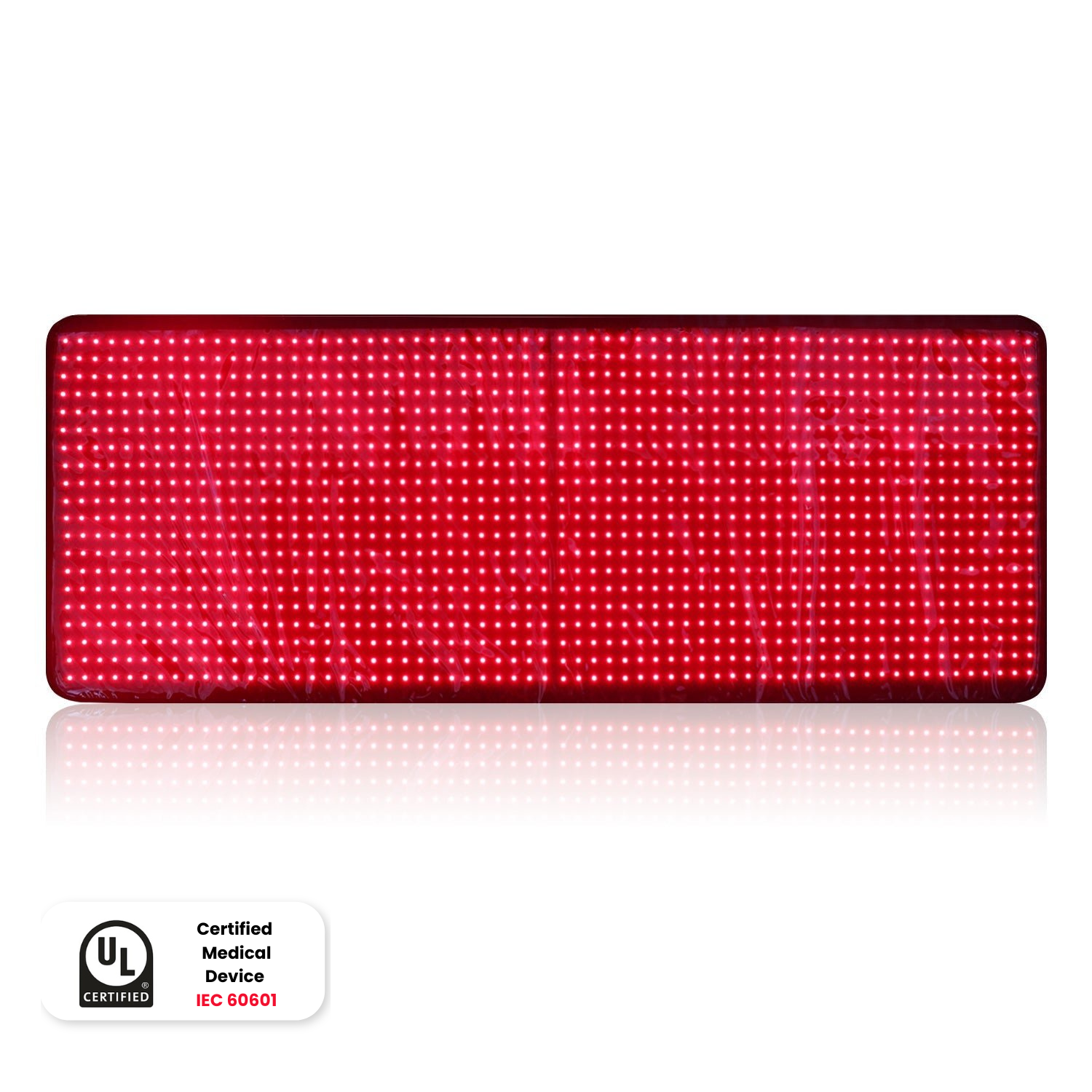DISCLAIMER: Mito Red Light devices are Class II wellness devices aimed at affecting the body through topical heating and supporting cellular function. The information provided in this article and on this site is for educational purposes only and is not intended to imply effectiveness of Mito Red Light devices for any specific application. The information provided in this article and on this site is not intended to diagnose, treat, cure, or prevent any disease, is not a substitute for consultation with a licensed medical provider and should not be construed as medical advice. Click here to read our article on potential contraindications of red light therapy..
Red light therapy is a new, exciting tool that people are using to improve their health and well-being. People use this form of therapy by shining red light on specific areas of the body to bring about a positive affect. Red light is used for a wide variety of reasons, from promoting sleep, to speeding wound healing, to managing chronic joint pain.
Red light is definitely an up-and-coming form of therapy; however, it involves many terms and concepts that might seem confusing to someone looking to learn more about it. Because the effect that it has on the body is a combination of physics, biology, and chemistry, these terms can be complicated. To fully understand content about red light therapy, it will be important to understand what some commonly-used red light therapy terms mean.
Light-Related Terms
The first set of red light therapy definitions that is important to understand are terms relating to light and the physics of how light and energy used by red light therapy work.
Electromagnetic Radiation
Electromagnetic radiation may sound like a complicated concept, but it just describes a common form of energy. Electromagnetic radiation is another term for light, but can also include invisible rays of energy such as the energy produced by a microwave, a radio, or even an X-ray. Red light and other light are a form of electromagnetic radiation and some sources will use the term electromagnetic radiation when describing light.
Wavelength
Electromagnetic energy travels in waves, and the length of each wave is very important in physics. One of the major discoveries that Albert Einstein is famous for is finding out that the energy of electromagnetic radiation is due entirely to its wavelength. The shorter the wavelength of electromagnetic radiation, the more energy it contains.
Red light has the longest wavelengths of visible light, while violet light contains the shortest wavelengths of light. This means that ultraviolet (UV) light is high-energy, while red light is low energy. This effect is why exposure to UV light increases the risk of cancer but exposure to red light, even very intense red light, does not.
Red Light
While it may seem obvious that red light is just a light that is red, the actual definition of red light is any light that has a wavelength of about 620-750 nanometers (nm). This light is defined by its wavelength, not its appearance.
Near-Infrared Light
Near-infrared (NIR) light is often used in red light therapy, but is technically not red light. NIR light has a wavelength of about 800-2500nm and is not visible to the human eye. The term “near” in NIR just classifies that type of infrared light as near the visible spectrum of light. Infrared light may also include far-infrared light; however, wavelengths from this type of light are not used in red light therapy.
Joules
A joule is a measurement of energy and is used to describe how much energy has been applied to something or how much energy an energy source is producing. Joules are sometimes used to measure how much energy a light source can produce. References to joules often occur when red light therapy products compare the energy they produce with other energy sources. Importantly, joules measure the total amount of energy produced.
Watts
A watt is a measurement of energy that is very similar to a joule, but measures energy over time. Watts measure the number of joules produced in one second. Two different energy sources can produce the same amount of energy, but if one takes longer to produce it, it produces less watts, or number of joules, per second. Examining the watts that a red light source produces allows you to see how quickly it delivers energy.
Biology-Related Terms
While there are many important terms relating to the light that red light therapy produces, it is also essential to understand several key terms about the biology of the body. These terms will help you to understand how red light actually causes an effect in the body.
Absorption
Absorption is a concept that relates both to the physics of light and to biology. When light that contains many different wavelengths meets a substance, the energy from the light is either reflected or absorbed, based on the chemical structure of the substance. Every chemical will absorb very specific wavelengths of light and reflect others. Using specific wavelengths of red and NIR light in red light therapy is incredibly important, because these wavelengths are the wavelengths that are actually absorbed by the target chemicals in the body.
Irradiance
Irradiance is a measure of how much light reaches a given area. This concept is very important in red light therapy because the more light that reaches the target area, the greater the effect will be. Irradiance is affected by power produced by the red light source, but also is affected by the distance that the skin is from the source.
Irradiance is often referenced when discussing how far a red light source should be from your skin. The closer you are to the source, the more intense the power will be reaching the area being irradiated. The tradeoff, however, is that being closer decreases the area that the light can reach. The further away you are from the source, the more area will be reached, but with less intensity.
Mitochondria
Mitochondria are organelles, tiny organs inside of cells that make cells work. These sub-microscopic structures are essential to the health of cells, producing energy and helping to control inflammation. While mitochondria are primarily known for producing the energy that cells need to function, they also play many other important roles, such as causing cells to automatically die and not over-replicate.
Electron Transport Chain
When the mitochondria produce energy, it transfers electrons between a sequence of proteins. These proteins are called the electron transport chain, because they move the electrons in a chain of chemical reactions. The last part of the electron transport chain is oxygen. The reason that most living things require oxygen to survive is that it is essential for energy-producing electrons to continue flowing through the electron transport chain.
Cytochrome C Oxidase
Another essential concept in red light therapy is a molecule called cytochrome C oxidase. This molecule is an important part of the electron transport chain and is essential for the cell to produce energy. This molecule absorbs red and near-infrared light, not only absorbing this light, but appearing to become more active and effective when it does. The main mechanism of red light therapy is thought to be caused because cytochrome C oxidase absorbs red light and becomes more active, increasing energy production in the cell and improving its function.
Nitric Oxide
Nitric oxide is a chemical that plays an important role in biological signaling. While it is not apparent how red light therapy causes the effect, research does indicate that red light therapy stimulates the release of nitric oxide. Nitric oxide signals blood vessels to dilate, allowing more blood flow to the areas where it is present.
Red light therapy is thought to increase circulation to areas where it is used, and nitric oxide seems to play an important role in this effect. Increased circulation causes many important health effects, allowing nutrients and oxygen to better reach the areas where blood flow is increased. This can speed healing, reduce inflammation and damage, and decrease pain.
Melanin
Melanin is a molecule that often comes up when discussing the effects of light on the body. Melanin is designed to absorb high-energy light, but may absorb some red light. Melanin is not thought to play a large role in affecting how light is absorbed, but may impact how effective red light therapy is in people who have high amounts of melanin.
One reason that melanin is often discussed in content providing information about red light therapy is that it is an example of a chemical that is made in response to light. Some level of melanin is constantly produced in our skin; however, this amount is increased when exposure to ultraviolet light occurs. Increased melanin is what causes a tan when you are out in the sun, and this increase is directly mediated by chemical reactions caused by light affecting your cells.
Mito Red Light
There are many different factors that can affect how effective red light therapy actually is. Having red light panels that deliver the correct wavelengths at the best intensity and still reach a large area is essential to optimize your treatments. Mito Red Light offers industry-leading devices that provide you with high-quality panels that are third-party tested and designed to give you the best effects possible.
Many of our products have all five star reviews by hundreds of customers. We have been in business for several years and provide some of the best red light therapy panels available today. We welcome you to review our selection of red light therapy devices or to contact one of our expert representatives at +1 866-861-6486 to learn more about us and the products that we provide.
Related Articles:
- What Is Red and Near Infrared (NIR) Light Therapy?
- Red Light Therapy Buyer’s Guide
- Everything You Need to Know About Red Light Therapy and SKIN































